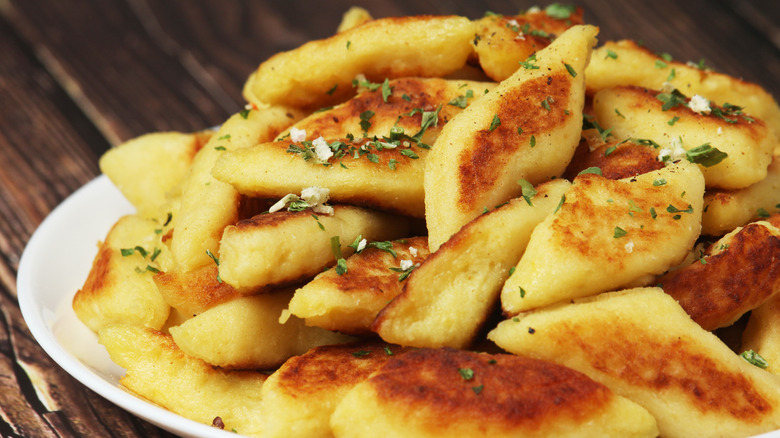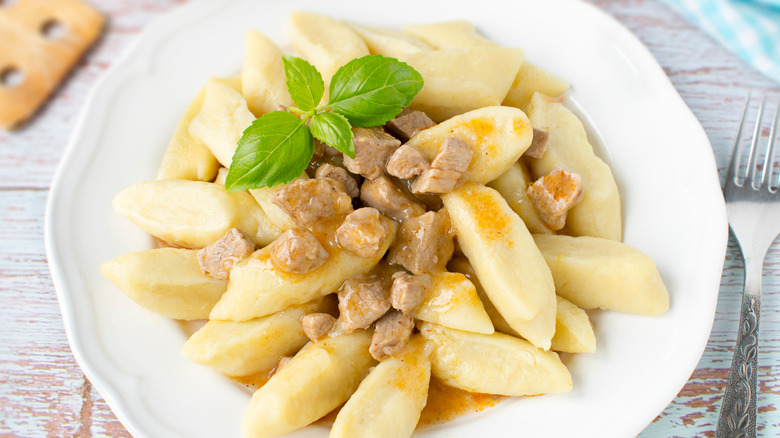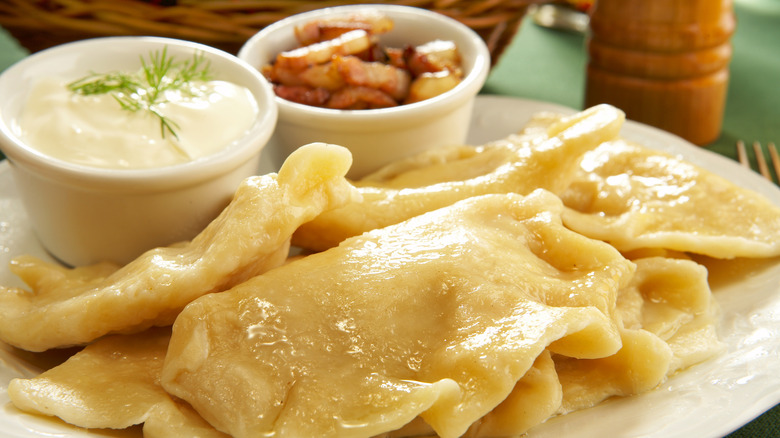Kopytka: The Polish Potato Dumplings You Need To Try
While many people might be familiar with the humble pierogi, the filled dumplings aren't the only food associated with Poland. Rooted in recipes passed down through the generations, many traditional dishes are hearty and humble. For cooks looking to add another Polish recipe to their cooking repertoire, kopytka might be a tasty choice.
Translated to mean "little hooves," Delighted Cooking describes kopytka as a dumpling made from potatoes, flour, egg, and seasonings. It is recommended to use freshly cooked potatoes versus leftover mashed potatoes or other pre-cooked options. After the ingredients are combined, the dough is rolled, cut diagonally, boiled, and sometimes fried. The potato dumplings can be served plain or topped with various options, including bacon, chives, or even just butter.
Although kopytka is similar to another Polish potato dumpling, pyzy, the main difference is the type of potatoes used. In kopytka, the potatoes are cooked, similar to Italian gnocchi. Whereas, pyzy uses raw, grated potatoes and mashed potatoes to make the dish. For a cooks looking for another spud-tastic dinner, it is time to "hoof" a serving of kopytka to the table.
What's the difference between kopytka and pierogis?
Although the pierogi might be more common or a holiday classic, the distance between that dish and kopytka isn't huge. Both dishes are classic Polish comfort foods. The recipes feature potatoes, can be served with butter, and topped with bacon, chives, and other condiments. Still, one main difference sets the two food choices apart. It's all about the dough.
A kopytka is simply the potato mixture, whereas the pierogi filling is surrounded by dough. King Arthur Baking describes a pierogi as a type of stuffed, boiled dumpling. While many recipes combine potato and cheese as a filling, it's the delicate balance between dough and filling that makes the perfect bite. (As with any dumpling recipe, a thin dough that lets the filling shine is usually preferred.)
Although there are variations on the dough, fillings, and toppings, one aspect ties both of the Polish foods together: a comforting flavor. From the humble potato to the simplicity of the recipe, the dish is meant to be a homemade bite that warms the heart as well as fills the belly. Whether it's a recipe from babka, a well-known culinary resource, or even an all new creation, Polish food is another example of a dumpling, which is a dish that can be found across many cultures. As the old Polish phrase says, "Appetite comes with eating." One serving of a kopytaka or pierogi might spark a conversation that creates a cultural connection across the table.
Popular traditional Polish foods have one thing in common
While Chef Sylwia might have earned the "potato girl" nickname on "Top Chef: World All Stars," her propensity for highlighting the humble potato is a concept mimicked across many popular Polish dishes. From the kopytka to the pierogi, the simple root vegetable can be transformed into a plethora of hearty, flavorful dishes. Other popular potato dishes include Silesian Voivodeship, a potato dumpling with a butter-filled hole that's often served with beer, and Placki ziemniaczane, a potato pancake served with a variety of toppings.
Although CNN Traveler uses the adjective "heartfelt" as a sentiment to describe popular Polish dishes, the emotional connection is more than just bolstering an internal feeling post-meal. The combination of large portions, humble ingredients, and traditional recipes create a personal connection beyond eating satisfaction. Soups such as Zurek, Flaki, and Czernina celebrate rustic cuisine and a nod to resourcefulness in choosing ingredients.
Even though Poland might not be the trending food destination, the list of traditional recipes that are closely tied to the region and its culture deserve a moment on the table. It is more than borsch, kielbasa, or the simple three ingredient Bigos. Grab a bottle of Polish vodka, explore the recipe book, and say the simple Polish toast "Man is not a camel, he must drink." And maybe include an addendum to say that he must try the bounty of Polish delicacies as well.


